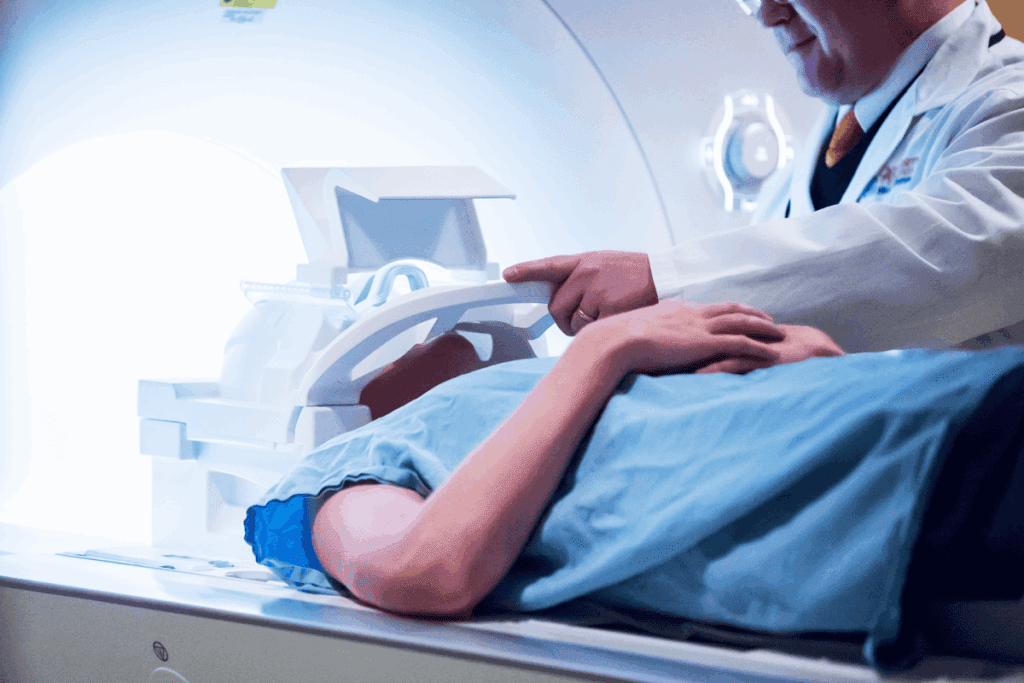Last Updated on November 26, 2025 by Bilal Hasdemir

At Liv Hospital, we know how important it is to tell apart interventional radiology and diagnostic radiology.
Radiology is a key medical field that uses imaging tech for both diagnosis and treatment. Diagnostic radiologists look at images to find diseases. On the other hand, interventional radiologists do minimally invasive, image-guided treatments for many conditions.
It’s vital for patients and healthcare workers to understand these differences. It really matters for patient care and treatment results.
Key Takeaways
- Interventional radiologists perform minimally invasive procedures.
- Diagnostic radiologists interpret imaging studies to diagnose diseases.
- The training and daily roles of interventional and diagnostic radiologists differ significantly.
- Interventional radiology is increasingly in demand for treating various medical conditions.
- Liv Hospital is committed to providing quality, patient-centered care.
- The distinction between these roles affects patient care and treatment outcomes.
The Fundamental Distinction in Radiology Specialties

Medical imaging is getting better, and so are the jobs of diagnostic and interventional radiology. These two areas of radiology are changing how we help patients.
The Evolution of Diagnostic and Interventional Branches
Diagnostic radiology has always been key in finding diseases. It uses X-rays, CT scans, and MRI to see inside the body. Interventional radiology is new and powerful. It uses the same tech to guide small procedures.
These two fields are not just different names. They have different ways of helping patients. Diagnostic radiology finds and describes diseases. Interventional radiology treats them with minimally invasive techniques.
Core Similarities and Differences at a Glance
At first, it might seem like diagnostic and interventional radiology are the same. They both use imaging tech. But they are used in very different ways.
- Diagnostic radiology is all about reading images to find diseases.
- Interventional radiology uses images to guide treatments.
Knowing the main similarities and differences helps us see the value of each field. They both play big roles in healthcare.
By understanding the unique jobs of diagnostic and interventional radiology, we see how they help patients. Both are essential in today’s medicine.
Interventional Radiologist vs Radiologist: Primary Role Differences

Interventional radiologists and diagnostic radiologists are key in radiology but have different roles. Knowing these differences helps us see how they help patients.
Diagnostic Radiologists: Masters of Image Interpretation
Diagnostic radiologists are experts at reading images to find diseases. They use X-rays, CT scans, MRI, and ultrasounds for accurate diagnoses. They are vital in patient care by helping plan treatments.
We count on them to:
- Read complex images
- Spot problems and diagnose
- Write detailed reports for treatment plans
Interventional Radiologists: Procedure-Focused Specialists
Interventional radiologists focus on doing procedures with image guidance. They treat conditions by going through blood vessels or other paths. They lead in new treatments, often avoiding traditional surgery.
Some of their procedures include:
- Angioplasty and stenting
- Embolization for bleeding or tumor treatment
- Biopsies and drainages
The Diagnostic-Treatment Continuum
The work of diagnostic and interventional radiologists is connected. They start with diagnosis and then treat. This teamwork ensures full patient care, from start to finish.
Knowing the roles of interventional and diagnostic radiologists shows their value in medicine. Together, they offer a complete care path that helps patients.
Training Pathways and Educational Requirements
Becoming a radiologist takes many years of education and training. For interventional radiologists, this includes extra training after finishing diagnostic radiology. Both types of radiologists start with a common base in radiology residency. But, their paths split as they move forward in their careers.
Core Radiology Residency: The Common Ground
All radiologists start with a core radiology residency. This lasts four to five years after medical school. They learn a lot about radiologic diagnosis and get some practice in interventional procedures.
This residency lays a broad foundation in:
- Radiation safety and protection
- Imaging techniques and modalities
- Contrast media and pharmacology
- Radiologic anatomy and pathology
Interventional Radiology Fellowship: The Additional Journey
Those aiming to be interventional radiologists add one to two years of training in an IR fellowship. This advanced training covers:
- Complex vascular and non-vascular interventions
- Advanced imaging techniques for procedural guidance
- Patient care and management in the context of interventional procedures
The Society of Interventional Radiology says, “Fellowship training in IR gives the needed skills for a wide range of minimally invasive procedures. It improves patient care and outcomes.”
“The extra training in interventional radiology fellowship programs prepares future IRs to innovate and lead in minimally invasive medicine.”
How Long Does It Take to Become an Interventional Radiologist?
Becoming an interventional radiologist takes 6 to 7 years of post-graduate training after medical school. This includes:
- 4-5 years of diagnostic radiology residency
- 1-2 years of IR fellowship training
This long training shows the complexity and specialized nature of interventional radiology. It’s a big part of why interventional radiologists can offer advanced care.
Procedural Scope: IR vs DR in Clinical Practice
Interventional radiology (IR) and diagnostic radiology (DR) have different roles in healthcare. Both are key in patient care but in different ways.
What Do Diagnostic Radiologists Do Daily?
Digital radiologists are vital in reading images like X-rays and CT scans. They make sure these images are correct. They work with other doctors to help patients get the right care.
Every day, they:
- Read imaging studies
- Share findings with doctors
- Work with other healthcare teams
- Keep up with new imaging tech
Common Interventional Radiology Procedures
Interventional radiologists do many procedures that are less invasive. These can be to diagnose or treat. Some common ones are:
| Procedure | Description |
| Angiography | Looks at blood vessels to find blockages |
| Biopsies | Takes tissue samples for tests |
| Tumor Treatments | Reduces tumor size or cuts off blood supply |
IR vs OR: Comparing Interventional Approaches with Traditional Surgery
IR is a less invasive option compared to open surgery. It causes less damage, has quicker recovery times, and fewer complications. IR treats vascular diseases, manages pain, and treats tumors without open surgery.
The main differences are:
- Less invasive
- Uses images for accuracy
- Shorter recovery
- Fewer complications
As technology improves, IR’s role grows. It offers new treatments and changes healthcare.
Patient Care Models and Clinical Involvement
Diagnostic and interventional radiologists play key roles in patient care. Diagnostic radiologists focus on making accurate diagnoses through imaging. On the other hand, interventional radiologists handle both diagnosis and treatment through minimally invasive procedures.
Consultative Role of Diagnostic Radiologists
Diagnostic radiologists act as consultants to other doctors. They provide critical information for diagnosis and treatment planning. Their skill in interpreting imaging studies is essential for making clinical decisions.
For example, when a patient gets a CT scan, the diagnostic radiologist checks the images. They spot abnormalities and share these findings with the referring doctor. This role is vital for ensuring patients get the right care for their conditions.
The Longitudinal Care Approach in Interventional Radiology
Interventional radiologists take a long-term approach to patient care. They perform procedures that diagnose and treat various conditions. This means they manage patient care from start to finish, not just at one point.
For instance, a patient with liver cancer might have several procedures done by an interventional radiologist. These could include chemoembolization or radioembolization. The radiologist keeps track of the patient’s response, adjusts the treatment plan as needed, and provides ongoing care.
Team Dynamics and Interdisciplinary Collaboration
Good patient care needs teamwork among healthcare professionals. Both diagnostic and interventional radiologists work in teams, bringing their expertise to patient management.
They work closely with other specialties, like medical oncologists and surgeons. For example, in cancer care, diagnostic radiologists team up with these specialists to offer complete care.
| Aspect | Diagnostic Radiology | Interventional Radiology |
| Primary Role | Consultative, providing diagnostic information | Procedural, performing treatments and managing conditions |
| Patient Interaction | Limited direct patient interaction, mainly through reports | Direct patient interaction before, during, and after procedures |
| Care Continuum | Typically involved in a single point of care (diagnosis) | Involved in longitudinal care (diagnosis, treatment, follow-up) |
It’s important to understand the differences between diagnostic and interventional radiologists. They have different approaches but the same goal: to improve patient outcomes through accurate diagnosis and effective treatment.
Lifestyle and Work Environment Comparison
Choosing a career in radiology means knowing the lifestyle and work environment differences. Interventional and diagnostic radiologists play key roles in patient care. Yet, their daily experiences differ a lot.
Balancing Procedures and Consultation in Interventional Radiology
Interventional radiologists have varied schedules, mixing procedures with consultations. This mix makes their workweek dynamic. They may work irregular hours, including evenings or weekends, for emergency cases.
They perform vascular interventions and tumor treatments. This requires technical skill and the ability to manage complex cases. They also play a key role in patient care before and after procedures.
Diagnostic Radiology Work Patterns
Diagnostic radiologists usually work regular hours. They focus on interpreting imaging studies, which is more predictable. Yet, they may need to be on call for urgent cases.
Their work environment is often more stable. Advances in technology allow for remote work. This can help with work-life balance but may lead to a sedentary lifestyle.
Schedule Realities: Do Radiologists Work Weekends?
Whether radiologists work weekends varies by specialty and setting. Interventional radiologists often work irregular hours, including weekends. This is due to the need for emergency procedures. Diagnostic radiologists may also work weekends or be on call, but it depends on the institution’s policies.
In summary, both interventional and diagnostic radiologists are vital in healthcare. Their lifestyles and work environments reflect different demands and opportunities. Knowing these differences is key for those considering a career in radiology.
How Competitive Is Interventional Radiology?
Interventional radiology is a specialized field that draws many applicants. This raises questions about how competitive it is. The competitiveness of a medical field depends on several factors. These include the number of available positions, the quality of applicants, and the demand for the specialty.
Application and Matching Statistics
To understand the competitiveness of interventional radiology, we need to look at application and matching statistics. The National Resident Matching Program (NRMP) provides data on applicants and positions in various specialties, including interventional radiology.
| Year | Number of Applicants | Available Positions | Match Rate |
| 2022 | 250 | 120 | 80% |
| 2021 | 230 | 115 | 78% |
| 2020 | 210 | 110 | 75% |
The data shows a competitive field. Many applicants are vying for a limited number of spots. The match rate is high, showing that well-prepared candidates have a good chance of getting a position.
Factors Driving IR’s Competitive Landscape
Several factors make interventional radiology competitive. Technological advancements and the growing demand for minimally invasive procedures make IR attractive. The complexity and variety of procedures, along with a good work-life balance, also appeal to many.
Also, the growing recognition of IR as a primary treatment option for various conditions has increased demand. This demand, combined with limited training positions, makes the field competitive.
Comparing Competitiveness with Other Specialties
When comparing interventional radiology to other specialties, we must consider several factors. These include the number of applicants, the match rate, and the demand for the specialty. While IR is competitive, other fields like dermatology and orthopedic surgery are also highly sought after.
Interventional radiology is unique because it combines technical skill, clinical knowledge, and patient care. Its innovative nature and the need for high expertise make it stand out in the field.
Career Outlook and Financial Considerations
Job market trends, compensation, and practice models shape a radiologist’s career. Looking into interventional radiology (IR) and diagnostic radiology (DR) shows why these factors are key. They help in choosing the right career path.
Job Market Trends for Both Specialties
The job market for radiologists is strong, thanks to an aging population and new medical imaging tech. But, interventional radiologists are in high demand. This is because their procedures are less invasive than traditional surgery.
Interventional radiologists are needed in hospitals and clinics for their complex procedures. Diagnostic radiologists are vital in all healthcare settings. They interpret imaging studies.
Compensation Differences Between IR and DR
Salaries for radiologists vary by location, practice type, and experience. Interventional radiologists usually earn more. This is because their work is more complex and procedural.
Interventional radiologists make about $600,000 a year, while diagnostic radiologists earn around $550,000. But, salaries can change based on where you work. Cities often pay more than rural areas.
Practice Models and Their Impact on Career Trajectory
The practice model a radiologist chooses affects their job satisfaction and money. Interventional radiologists often work in hospitals or IR clinics. They do a lot of procedures. Diagnostic radiologists work in hospitals too but might also find jobs in private practices or teleradiology.
Practice models can also affect your work-life balance. Some jobs offer regular hours, while others require more on-call time. Choosing between private practice, academia, or hospitals changes your career and financial future.
It’s important for radiologists to understand these factors. This way, they can make career choices that fit their personal and professional goals.
Conclusion: Making an Informed Specialty Choice
It’s important to know the differences between interventional radiologists and radiologists. This is true for patients, healthcare workers, and those thinking about a career in radiology. We’ve looked at the main differences, training, and job outlooks for both fields.
Interventional radiologists and radiologists have different jobs, training, and paths in their careers. Radiologists mainly interpret images. On the other hand, interventional radiologists perform procedures on patients. When choosing a career in radiology, it’s key to consider these differences and the job outlook for each field.
The choice between being a diagnostic radiologist or an interventional radiologist depends on personal preferences and career goals. Knowing these differences helps us make better career choices. Both specialties have a bright future, with more jobs available in healthcare.
FAQ
What is the main difference between an interventional radiologist and a diagnostic radiologist?
Interventional radiologists treat conditions with image-guided procedures. Diagnostic radiologists diagnose diseases by interpreting imaging studies.
How long does it take to become an interventional radiologist?
It takes years to become an interventional radiologist. First, you need to complete a core radiology residency. Then, you do a fellowship program, which adds more time.
What do diagnostic radiologists do daily?
Daily, diagnostic radiologists interpret imaging studies like X-rays and MRIs. They provide this information to help doctors diagnose diseases.
What are some common interventional radiology procedures?
Interventional radiologists do many procedures. These include angiography, tumor treatments, and vascular interventions. They use images to guide these treatments.
How competitive is interventional radiology?
Interventional radiology is very competitive. Many people apply for a few spots, making it tough to get in.
Do radiologists work weekends?
Diagnostic radiologists usually work regular hours but might work weekends or be on call. Interventional radiologists also have varied schedules, including on-call duties.
What is the difference between IR and DR in terms of patient care?
Diagnostic radiologists give diagnostic information to doctors. They help diagnose diseases. Interventional radiologists, on the other hand, treat patients with procedures and manage their conditions.
What are the career outlook and financial considerations for interventional radiologists and diagnostic radiologists?
The career outlook and pay for interventional and diagnostic radiologists differ. Job market trends, pay, and practice models all play a role in their careers.
Is interventional radiology a surgical specialty?
No, interventional radiology is not a surgical specialty. It’s a minimally invasive field that uses images to treat conditions, often as an alternative to surgery.
What is the role of interventional radiologists in patient care?
Interventional radiologists play a key role in patient care. They perform procedures, manage conditions, and care for patients throughout their treatment.
References
Shrestha, O., Basukala, S., Thapa, N., et al. (2023). Endovenous laser ablation versus conventional surgery (ligation and stripping) for primary great saphenous varicose vein: A systematic review and meta-analysis. Annals of Medicine and Surgery, 85, 4509-4519. https://pubmed.ncbi.nlm.nih.gov/37663729/






